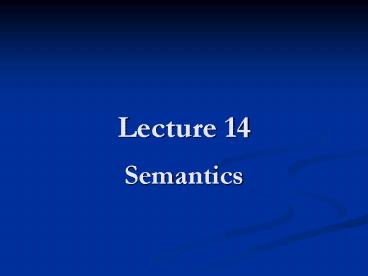Semantics - PowerPoint PPT Presentation
1 / 11
Title:
Semantics
Description:
In semantic analysis, there is always an attempt to focus on ... (b) bull, rooster, drake, ram. The (a) and (b) words are. The (a) words are. The (b) words are ... – PowerPoint PPT presentation
Number of Views:125
Avg rating:3.0/5.0
Title: Semantics
1
Lecture 14
- Semantics
2
Semantics
- The study of the meaning of words, phrases and
sentences. - In semantic analysis, there is always an attempt
to focus on what the words conventionally mean. - This technical approach emphasizes the objective
and the general ( conceptual meaning). - It avoids the subjective and the local (
associative meaning).
3
Conceptual versus associative meaning
- Conceptual meaning covers those basic, essential
components of meaning which are conveyed by the
literal use of a word. - Associative meaning the stylistic meaning of
words. - Needle conceptual meaning thin, sharp, steel
instrument. - One of the associative meanings of Needle may be
painful.
4
Semantic features
- Semantic properties The components of meaning of
a word. - Semantic feature A way of analyzing meaning by
demonstrating the presence or absence of semantic
properties using pluses and minuses. - Example of componential analysis
- baby is young, human, abstract.
5
Identify the features (1)
- 1. (a) widow, mother, sister, aunt, maid
- (b) widower, father, brother, uncle, valet
- The (a) and (b) words are
- The (a) words are
- The (b) words are
human
female
male
- 2. (a) bachelor, paperboy, pope, chief
- (b) bull, rooster, drake, ram
- The (a) and (b) words are
- The (a) words are
- The (b) words are
male
human
animal
6
Identify the features (2)
- 3. (a) table, stone, pencil, cup, house, ship
- (b) milk, alcohol, rice, soup, mud
- The (a) words are
- The (b) words are
count
- count
- 4. (a) pine, elm, sycamore
- (b) dandelion, aster, daisy
- The (a) and (b) words are
- The (a) words are
- The (b) words are
plant
tree
flower
7
Lexical Relations
- Synonymy words that have the same meanings, e.g.
start begin. - Antonymy words that are opposites in meanings,
e.g. hot cold. - Hyponymy Words whose meanings are specific
instances of a more general word, e.g. rose and
daffodil are hyponyms of the word flower. - Prototypes help explain the meaning of words not
in the terms of component features but in the
terms of resemblance to the clearest exemplar.
8
Semantic Relations among Words
- Homonymy A word which has two or more entirely
distinct meanings, e.g. club a social
organization a blunt weapon. - Homophony Different words pronounced the same
but spelled differently, e.g. two and too. - Polysemy A word which has two or more related
meanings, e.g. bright shining intelligent
9
Identifying homophones
- 1. ste? ?
1. Stair, stare
2. weist ?
2. waste, waist
3. sili? ?
3. sealing, ceiling
4. kju ?
4. cue, queue
5. sent ?
5. sent, cent, scent
10
Identifying Homonyms in Jokes
- 1. Time flies like an arrow
- Fruit flies like a banana
2. Policeman Why have you parked your car here?
Motorist Because the sign says Fine for
Parking.
3. Customer Have you got half-inch nails?
Ironmonger Yes, sir. Customer Then could
you scratch my back. Its very itchy
11
More semantic relations among words
- Metonymy A word substituted for another word
with which it is closely associated, e.g. diamond
for a baseball field. - Collocations words frequently occurring together
- Such as salt and pepper, husband and wife, and
knife and fork.































